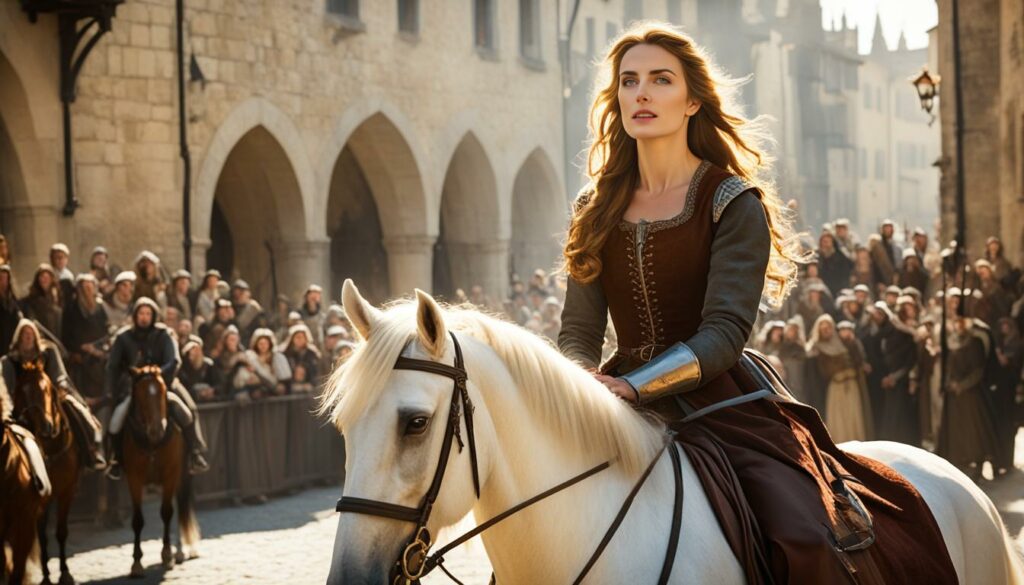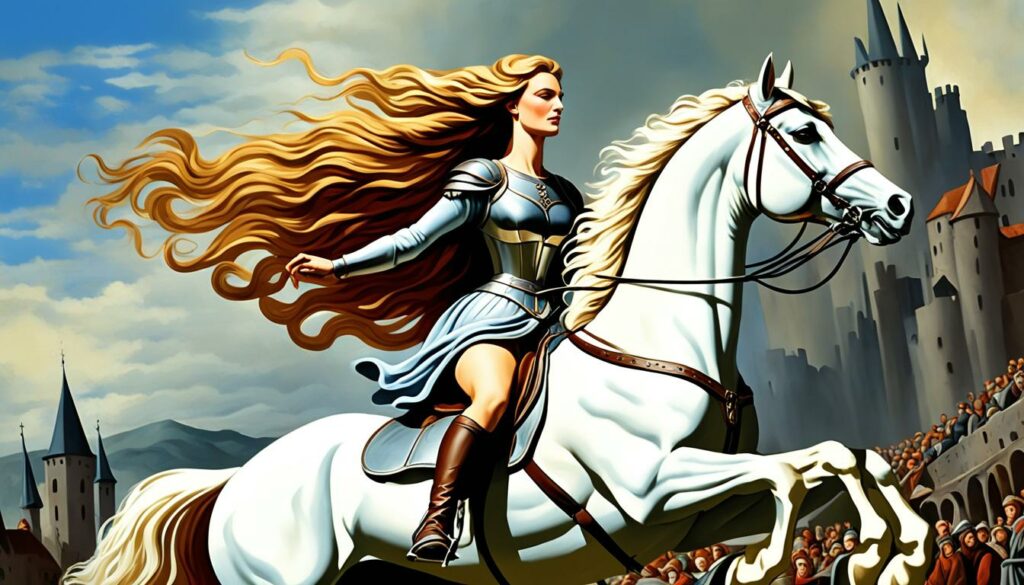Lady Godiva, the iconic figure from English history, has captured the imagination of people for centuries. Her story, however, has been cloaked in myth and folklore, making it challenging to discern fact from fiction. In this article, we embark on a journey to uncover the truth behind the legend of Lady Godiva
By delving into historical references and examining various accounts, we aim to illuminate the enigmatic Lady Godiva and unravel the mysteries surrounding her. From her famous naked ride through the streets of Coventry to her relationship with Earl Leofric, we will explore every facet of Lady Godiva’s story.
Our investigation will extend to the origins of the Godiva legend and the role of Peeping Tom in the story. We will also dive into Lady Godiva’s impact on the people of Coventry and her contributions to Anglo-Saxon England. Throughout this article, we will evaluate the credibility of the Godiva legend and analyze the historical references that attest to the existence and actions of Lady Godiva. Our goal is to provide you with a comprehensive understanding of who Lady Godiva truly was and separate the truth from the fiction that has surrounded her for centuries.
Stay tuned as we explore the fascinating life and legacy of Lady Godiva, uncovering the captivating story behind this historical figure.
Who was Lady Godiva, and What is Her Story?
In this section, we will introduce Lady Godiva and explore the fascinating details of her story. We will also uncover the truth behind the legend surrounding her and separate fact from fiction.
Introduction to Lady Godiva
Lady Godiva is an iconic figure from English history who has captured the imagination of people for centuries. She is known for her legendary act that has been perpetuated throughout time, leaving a mark on history.
The Legend of Lady Godiva’s Naked Ride
One of the most famous aspects of Lady Godiva’s story is the legendary naked ride she undertook through the streets of Coventry. The tale tells of her plea to her husband, Earl Leofric, to ease the tax burden on the townspeople and his agreement on the condition that she ride naked through the city. The ride symbolizes her bravery and selflessness, but the historical accuracy of this event is a subject of debate among historians.
Historical Background: Lady Godiva and Earl Leofric
To understand Lady Godiva’s story fully, it is essential to explore the historical background of her relationship with Earl Leofric. Earl Leofric was a powerful nobleman in Anglo-Saxon England and the husband of Lady Godiva. Together, they ruled over the region of Mercia, and their partnership played a significant role in shaping the events surrounding Lady Godiva’s legend.
Exploring the Truth Behind the Legend
In this section, we delve deeper into the origins of the Godiva legend and explore the possible sources that led to the development of this iconic tale. We aim to shed light on the truth behind the Lady Godiva story by examining historical accounts and cultural references.
Origins of the Godiva Legend

The origins of the Godiva legend are rooted in medieval folklore and historical accounts. The tale of Lady Godiva’s naked ride through the streets of Coventry has captivated imaginations for centuries. While the exact origins of the legend remain uncertain, it is believed to have emerged during the 11th century.
One theory suggests that the legend was inspired by an ancient pagan ritual where a young woman would ride through the streets unclothed to ensure prosperity for the community. Over time, this ritual evolved and became intertwined with the story of Lady Godiva.
The Role of Peeping Tom in the Story
One of the most famous aspects of the Godiva legend is the presence of Peeping Tom, a character who allegedly watched Lady Godiva’s ride and was subsequently struck blind. This element adds a dramatic touch to the tale, but its historical accuracy is debated.
Some speculate that Peeping Tom is a later addition to the story, serving as a cautionary figure to discourage voyeurism. Others argue that the character may have originated from local folklore or may symbolize the moral implications of witnessing an act of bravery and selflessness.
Lady Godiva’s Influence on the People of Coventry
Lady Godiva’s actions and reputation significantly impacted the people of Coventry. Her famous ride, which was said to be a plea for tax relief to alleviate the burden on the townspeople, symbolized her empathy and advocacy for the common people.
Lady Godiva’s act of selflessness and courage made her a revered figure in Coventry, and she became a symbol of local pride and resilience. Her legend continued to shape the identity and cultural heritage of the city, inspiring generations to uphold the values of compassion, fairness, and justice.
Understanding Lady Godiva’s Impact on Anglo-Saxon England
In this section, we will explore Lady Godiva’s profound impact on Anglo-Saxon society. Her contributions to the city of Coventry and her efforts to improve the lives of its citizens demonstrate her lasting legacy.

Godiva’s Contribution to the City of Coventry
Lady Godiva’s impact on Coventry cannot be overstated. She dedicated herself to the city’s and its people’s welfare, using her wealth and influence to bring about positive change.
One of her most notable contributions was the construction of a market hall, which provided the people of Coventry with a central gathering place for trade and commerce. This initiative stimulated economic growth and fostered a sense of community among the residents.
Furthermore, Lady Godiva’s philanthropic efforts included establishing educational institutions, such as schools and libraries, which provided the people of Coventry with access to knowledge and learning opportunities. Her commitment to education ensured that future generations would have the tools to thrive and succeed.
Additionally, Lady Godiva actively supported the arts, patronizing local artists and musicians. This cultural patronage enriched the city’s cultural landscape and uplifted its inhabitants’ spirits.
The Alleged Miracle: Lady Godiva Strikes Peeping Tom Blind
Another significant event attributed to Lady Godiva is the alleged miracle where she struck a man named Peeping Tom blind. According to the legend, Godiva requested the people of Coventry to remain indoors as she rode through the streets naked to protest a tax imposed by her husband, Earl Leofric.
While most of the townspeople respected her wishes, Peeping Tom disobeyed and peered out of his window, only to be struck blind as punishment for his voyeurism. This miraculous event became emblematic of Lady Godiva’s unwavering commitment to her cause and her ability to inspire change.
The Godgifu Monastery: Lady Godiva’s Endowment
As a testament to her religious devotion and desire to give back to the community, Lady Godiva endowed the Godgifu Monastery in Coventry. This monastery served as a center for spiritual growth and provided support to the local clergy.
The Godgifu Monastery, also known as St. Mary’s Priory, became a place of worship and solace for the people of Coventry. It housed monks and nuns dedicated to a life of prayer and service.
Lady Godiva’s generous endowment ensured the monastery’s sustenance and allowed it to continue its religious and charitable activities for centuries, becoming an enduring symbol of her lasting impact.
Separating Fact from Fiction: Historical References to Lady Godiva
In this final section, we delve into the historical references to Lady Godiva and assess their credibility. Accounts by chroniclers, including Roger of Wendover and others, provide valuable insights into the story of Lady Godiva. These chroniclers, who meticulously documented events of their time, offer a glimpse into the life and actions of this enigmatic figure.
The presence of Lady Godiva in the Domesday Book further bolsters her historical significance. This comprehensive survey of England carried out in 1086 includes her as a landowner in Warwickshire, cementing her status as a real person in the annals of history.
While the Godiva legend has captured our imagination for centuries, it is crucial to evaluate its credibility. By critically analyzing the historical evidence, we can separate reality from embellishment. The accounts by chroniclers and Lady Godiva’s inclusion in the Domesday Book contribute to the veracity of her existence, lending weight to her story.

